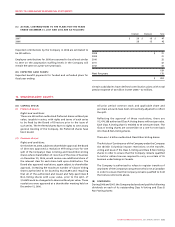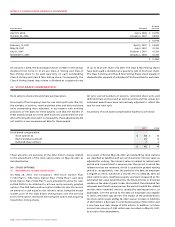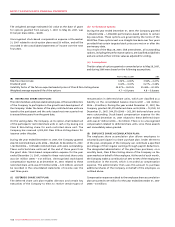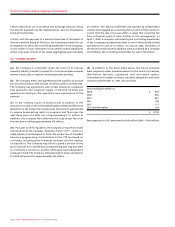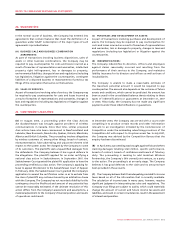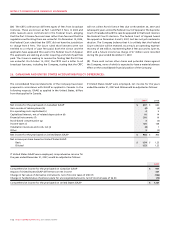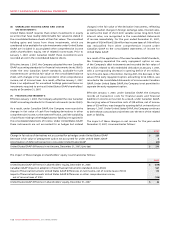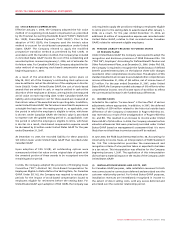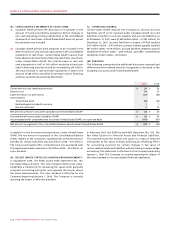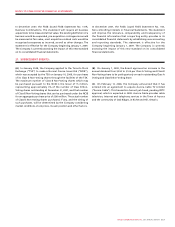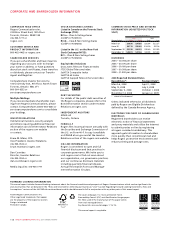Rogers 2007 Annual Report Download - page 119
Download and view the complete annual report
Please find page 119 of the 2007 Rogers annual report below. You can navigate through the pages in the report by either clicking on the pages listed below, or by using the keyword search tool below to find specific information within the annual report.
ROGERS COMMUNICATIONS INC. 2007 ANNUAL REPORT 115
NOTES TO CONSOLIDATED FINANCIAL STATEMENTS
(G) STOCK-BASED COMPENSATION:
Effective January 1, 2006, the Company adopted the fair value
method of recognizing stock-based compensation as prescribed
by the Financial Accounting Standards Board (“FASB”) Statement
No. 123(R), Share-Based Payments (“FAS 123(R)”). Prior to the
adoption of FAS 123(R), the Company used the intrinsic value
method to account for stock-based compensation under United
States GAAP. The Company elected to apply the modified
prospective transition method as permitted by FAS 123(R). In
accordance with the transition method, the Company has included
in its United States GAAP income the cost of the outstanding and
unvested options commencing January 1, 2006, net of estimates for
forfeiture rates. For Canadian GAAP, the Company adopted the fair
value method of recognizing stock-based compensation expense
beginning January 1, 2004.
As a result of the amendment to the stock option plans on
May 28, 2007, all of the Company’s outstanding stock options can
now be settled in cash at the discretion of the employee or director
(note 20(a)(i)). Under United States GAAP, the cost of stock-based
awards that are settled in cash, or may be settled in cash at the
discretion of the employee or director, are required to be measured
at fair value on each reporting date. Under Canadian GAAP, the
liability and compensation cost for these awards are measured at
the intrinsic value of the awards at each reporting date. In addition,
under United States GAAP, the fair value is amortized to expense on
a straight-line basis over the vesting period or, as applicable, over
the period in which the employee is eligible to retire, whichever
is shorter. Under Canadian GAAP, the intrinsic value is amortized
to expense over the graded vesting period or, as applicable, over
the period in which the employee is eligible to retire, whichever
is shorter. As a result, stock-based compensation expense would
be decreased by $3 million under United States GAAP for the year
ended December 31, 2007.
At December 31, 2007, the recorded liability for these awards is
$33 million lower under United States GAAP than recorded under
Canadian GAAP.
Upon adoption of FAS 123(R), all outstanding options were
remeasured at their fair value on the original date of grant with
the unvested portion of these awards to be recognized over the
remaining service period.
In 2006, the Company adopted the provisions of Emerging Issues
Committee (“EIC”) Abstract 162, Stock-Based Compensation for
Employees Eligible to Retire Before the Vesting Date, for Canadian
GAAP. Under EIC 162, the Company was required to restate prior
periods for the impact of stock-based compensation issued to
employees eligible for retirement before the vesting date. For
United States GAAP, upon adoption of FAS 123(R), the Company was
only required to apply the provisions relating to employees eligible
to retire prior to the vesting date to awards issued after January 1,
2006. As a result, for the year ended December 31, 2006, an
additional $2 million of compensation expense was recorded under
United States GAAP, relative to that recorded under Canadian
GAAP, related to retirement-eligible employees.
(H) PENSION LIABILIT Y REL ATED TO FUNDED STATUS
OF PENSION PLANS:
Under United States GAAP, the Company was required to adopt the
recognition and disclosure provisions of FASB Statement No. 158
(“FAS 158”), Employers’ Accounting for Defined Benefit Pension and
Other Postretirement Plans, as at December 31, 2006. Under FAS 158,
the Company is required to recognize the funded status of defined
benefit postretirement plans on the balance sheet with changes
recorded in other comprehensive income (loss). The adoption of this
standard resulted in an increase to accumulated other comprehensive
income at December 31, 2006, of $50 million, net of income taxes of
$27 million. For the year ended December 31, 2007, under United
States GAAP, the Company recorded a decrease of $15 million to other
comprehensive income, net of income taxes of $6 million to reflect
the current period increase in the funded status differences.
(I) INCOME TAXES:
Included in the caption “Income taxes” is the tax effect of various
adjustments where appropriate. In addition, in 2007, the deferred
tax liability of $254 million related to the historical outside basis
difference of the Company’s investment in Rogers Wireless Inc.
was reversed as a result of the amalgamation of Rogers Wireless
Inc. and RCI. This resulted in an increase to income under United
States GAAP of $254 million. In 2006, the Company released certain
valuation allowances that were previously recorded under United
States GAAP based on management’s assessment that it is more
likely than not that these income tax assets will be realized.
In June 2006, the FASB issued Interpretation No. 48, Accounting for
Uncertainty in Income Taxes, an Interpretation of FASB Statement
No. 109. This interpretation prescribes the measurement and
recognition criteria of a tax position taken or expected to be taken
in a tax return. This interpretation was effective for the Company
beginning January 1, 2007. The application of this interpretation
did not have a material impact on the results of the Company under
United States GAAP.
(J) INSTALLATION REVENUES AND COSTS, NET:
For Canadian GAAP purposes, cable installation revenues for both
new connects and re-connects are deferred and amortized over the
customer relationship period. For United States GAAP purposes,
installation revenues are immediately recognized in income to
the extent of direct selling costs, with any excess deferred and
amortized over the customer relationship period.


